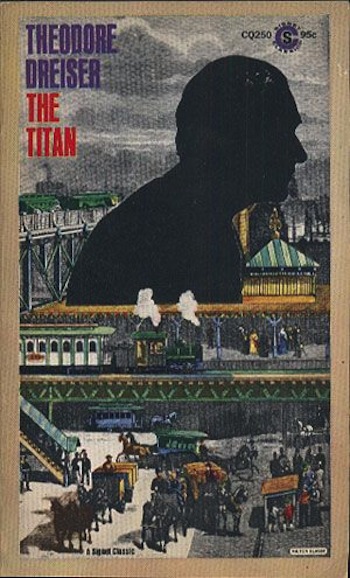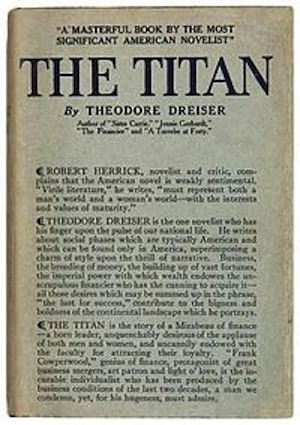Book Commentary: Dreiser’s “The Titan” Turns 100 — America’s “Downton Abbey”
Theodore Dreiser’s The Titan is not the greatest novel about American business, but it is among the best, an honorable runner-up that turned 100 this year.
By Bill Marx

I have a thing about the 100th birthday of important books, especially those of historical and aesthetic merit whose anniversaries are, for some unaccountable reason, overlooked by literary as well as mainstream magazines. Before the year ends I must pay homage to an American novel that, after multiple Google searches, appears to have been completely passed over, And that silence is disgraceful — I have read all 500 pages of The Titan by Theodore Dreiser (the Signet Classics edition with an amusing afterword by poet John Berryman, who was born in 1914) and the narrative holds up quite well after a century. I will not be able to pay sufficient respect to Dreiser’s mastery here – this is essentially a shout-out to the curious before 2015 arrives. Because we are in the midst of our own Gilded Age, The Titan‘s neutral portrait of the rise of a treacherous multi-millionare who cheats, bribes, and sleeps his way to economic domination takes on particular resonance. There are few contemporary American novelists who have had the nerve to take on the rise of the super-rich, let along with Dreiser’s depth of detail and steely-eyed insight.
The Titan is a sequel to The Financier, Dreiser’s novel about the rise and apparent fall of transportation magnate Frank Cowperwood. In 2012, the Wall Street Journal took notice of the latter book’s centenary, scholar Leonard Cassuto aptly noting that “Dreiser’s constant probing of the intertwined needs for money, art, glory, sex and so much else … makes The Financier the greatest of all American business novels.” Cowperwood is Dreiser’s Darwinian anti-hero: in him, we see evolution giving birth to the conscienceless psyche of the 1%, personalities who are amoral enough, brutal enough, treacherous enough, and insolent enough to manipulate capitalism to the tune of countless millions. In Dreiser, however, the battle for supremacy is not as much about accumulating wealth – or gaining social position — as it is about winning enough power to assert control, to be able to shape the future as well as the present.
His mercilessness masked by a genial temperament, Cowperwood is an archetypal American predator, co-opting the financial game by exploiting the insecurities and greed of others. (The character’s career was inspired by the cutthroat mayhem of C. T. Yerkes, one of the frisker Gilded Age robber barons.) Dreiser’s giant is not an ancestor of the greedy Wolf of Wall Street; he is a link between Henry James’s effete millionare in The Golden Bowl and Charles Foster Kane in Citizen Kane (Orson Welles and Herman J. Mankiewicz must have been familiar with The Financier and The Titan). Like those fictional men of power, Cowperwood is fascinated by high art, though for Dreiser beauty turns out to be more liberating than money or sex. In the first two volumes of his career Cowperwood is not imprisoned by beautiful things — women, art — in mysterious ways they seem to inspire him to crush others. (Think of Wal-Mart heiress Alice Walton opening the Crystal Bridges Museum of American Art in her hometown of Bentonville, Ark.)

An edition of “The Titan”
Why did WSJ overlook The Titan? I don’t know — it serves up much of what made the first book so memorable: “It was now the day of the trust in all its watery magnificence.” Cowperwood moves his conniving operations from Philadelphia to Chicago, where he sets up the same take-no-prisoners march toward monopolizing the city’s growing street railway lines — he buys and sells politicians, corrupts bankers and gullible investors, beds the wives of friends and foes. (He even has a turn with a half-Jewish bohemian gal!) Cowperwood is stopped short of setting up a transportation kingdom by the rise of populist fervor at the turn of the century — Chicago’s masses are whipped up into a frenzy by rival businessmen and their megaphone-newspapers. At the end of the book a 60-ish Cowperwood moves into his monumental New York mansion (stuffed with masterpieces) with his recently won supergal — a barely twenty-something wife-to-be of hard-bitten yet sophisticated sensibility. Critic H.L. Mencken, Dreiser’s pitchman, adored the book, huzzahing that it was a novel “without the slightest hint of a moral … not a single appeal to the emotions is in it: it is a purely intellectual account, as devoid of heroics as a death certificate, of a strong man’s savage endeavors to live out his life as it pleases him, regardless of all the subtle and enormous forces that seek to break him to a rule.” This makes Cowperwood sounds like a Tea Party pin-up boy.
Despite Mencken’s enthusiasm, The Titan does show a falling off from the earlier volume, partly because its storyline reprises the swashbuckling rise of The Financier without adding any new or formidable obstacles. That said, there are plenty of savory characterizations and demolition jobs, from the expert destruction of the soul of the blond-chasing mayor Sluss to the splendid scene where Cowperwood’s second wife, Aileen, physically attacks Cowperwood’s mistress in public. The portraits of the smaller bloodsuckers on the body politic are particularly entertaining. Here is a Chicago ward alderman:
Smiling Mike Tiernan, proud processor of four of the largest and filthiest saloons of this area, was a man of large and genial mold — perhaps six feet one in height, broad-shouldered, with a bovine head, bullet-shaped from one angle, and big, healthy, hairy hands and large feet. He had done many things, from digging in a ditch to occupying a seat in the city council from this his beloved ward, which he sold out regularly for one purpose and another; but his chief present joy consisted in sitting behind a solid mahogany railing at a rosewood desk in the back portion of his largest Clark Street hostelry — The Silver Moon. Here he counted up the returns from his various properties — saloons, gambling resorts, and houses of prostitution — which he manipulated with the connivance or blinking courtesy of the present administration, and listened to the pleas and demands of his henchmen and tenants.
With his smiling geniality, his “bovine head” and “big, healthy, hairy hands,” his obvious sense of power as he listens to the “pleas and demands of henchmen and tenants” in The Silver Moon, Tiernan is a mini-Titan. Few writers wrote as well about the links in the American food chain — from the little bullies up to the big bullies.

The first edition cover of “The Titan.”
More harmful than its repetition is The Titan‘s focus on Cowperwood’s search for the ‘fittest’ mate — the spiritually inadequate Aileen turns to other men, smoking (!), and drink because of Cowperwood’s neglect. The book’s structure is lumpy and stuttering because Dreiser interrupts dramatizing financial and political shenanigans in order to deal with Cowperwood’s misbegotten romances, culminating in his selection of the somewhat etherial Berenice (perhaps, as a bow to Yerkes’s yen for adolescent girls, Cowperwood is first smitten by Berenice when she is in her early teens). Mencken is wrong when he argues that Dreiser eschews the sentimental and intellectual; the author is at his worst when he turns in either direction, and he does so far too often during The Titan‘s marriage quest. His women are stick figures, and the romantic rhetoric is embarrassingly macho/puerile: “…he could not forgive her for not loving him perfectly, as had so many others,” “Back of the onward sweep of generalizations he himself sensed the mystic Aphrodite and her magic.” And when Dreiser generalizes about existence the result is downright preposterous: “At the ultimate remove, God or the life-force, if anything, is an equation, and at its nearest expression for man — the contract social — it is that also.”
So yes, we are back to the old charge that Dreiser is a major American writer whose prose, at times, is as terrible as his detractors charge. (Does anyone read him any longer? Perhaps his enemies have won, which would be a shame.) But so what? As Irving Howe argues, “despite the many patches of gray and occasional patches of purple prose, Dreiser manages to accumulate large masses of narrative tension; he pulls one, muttering and bruised, into the arena of his imagination; and finally one has no recourse but surrender to its plentitude, its coarse and encompassing reality.” The Titan lacks a good bit of the narrative zest and cut throat entrepreneurism of The Financier — it is not the greatest novel about American business, but it is still exuberant enough to be among the best, at the very least an honorable runner-up.
In these two wonderful books, chockablock with crude but pungent reality, the tyrannical machinations of the Gilded Age come draped in ersatz Darwinian trappings, huge forces of wealth and media battling it out hammer and tong. Here we have America’s winner-take-all version of TV’s Downtown Abbey. Our aristocrats – guileful moneymakers extraordinare – exert their influence through hypocrisy and chicanery, betrayal and double-dealing, sexual promiscuity and lies. They manipulate the masses, buy inside information, order about their “henchmen and tenants,” and pocket politicians. Better than any of our writers, Dreiser knew that America’s desire for more never settles for less.
Bill Marx is the Editor-in-Chief of The Arts Fuse. For over three decades, he has written about arts and culture for print, broadcast, and online. He has regularly reviewed theater for National Public Radio Station WBUR and The Boston Globe. He created and edited WBUR Online Arts, a cultural webzine that in 2004 won an Online Journalism Award for Specialty Journalism. In 2007 he created The Arts Fuse, an online magazine dedicated to covering arts and culture in Boston and throughout New England.
Tagged: Frank Cowperwood, Gilded Age, The Financier, The Titan

I read the “trilogy of passion” last year.
I hope you are amused.
Hi Mark,
I am impressed … any thoughts on the relative merits of The Financier and The Titan? Most readers find The Stoic to be a disappointment.
If we accept that Cowperwood succeeds in spite of and not because of his reprehensible behavior, then each book reveals an important lesson.
Each title bares witness to the lesson contained.
In The Financier, we observe that if one controls a large enough order flow, then one can earn sufficient income to accumulate capital.
The Titan reveals that to achieve above market rates of return on large amounts of capital one must have monopoly power. Therefore the focus moves to the halls of political power rather than the arena of commerce. Warren Buffet just published a reflection on his own career and points out the same truth.
Finally, in The Stoic Dreiser reminds us of the reality described so well in Fight Club. “On a long enough time line the survival rate for everyone drops to zero.”